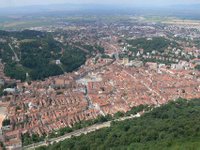
It is not difficult to see why Brasov has become “Little Prague” and is the second most visited Romanian destination. The town has preserved its medieval architecture well and Mount
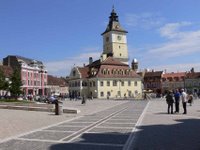 Tampa, looming over the city, provides spectacular views. The pleasant Piata Sfatului welcomes tourists with trendy cafes and hours of people watching. Pedestrian-only Strada Republicii with its bakeries, terraces, and boutiques adds to the old meets modern.
Tampa, looming over the city, provides spectacular views. The pleasant Piata Sfatului welcomes tourists with trendy cafes and hours of people watching. Pedestrian-only Strada Republicii with its bakeries, terraces, and boutiques adds to the old meets modern.With a day of wandering, food was one of our fun experiences. We enjoyed excellent crepes at La Republique and Italian Pizza at Pizza Roma. My wife’s incessant quest for pastries led us to the orange-colored pastry chain, Fornetti with its ultra-cheap, but utterly delicious nuggets filled with cheeses, chocolate, and jams. Our visit to the market presented fresh apricots for an afternoon snack!
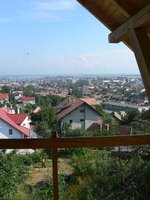 We spent the evening in Brasov at Pensiunea Ovesea with its magnificent views of the town. Only ten minutes from the downtown, the Pensiune was cheerfully decorated and our hosts gracious and appreciative of our positive reviews of their one-year-old property. The Brasov area
We spent the evening in Brasov at Pensiunea Ovesea with its magnificent views of the town. Only ten minutes from the downtown, the Pensiune was cheerfully decorated and our hosts gracious and appreciative of our positive reviews of their one-year-old property. The Brasov area 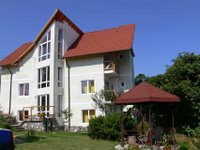 has a well-developed tourism infrastructure, and it is flush with tourists. As a result, prices here tend to be considerably higher than in the rest of Romania. Yet, you can still find nice lodging at good prices (around 35 Euros—$40-$45).
has a well-developed tourism infrastructure, and it is flush with tourists. As a result, prices here tend to be considerably higher than in the rest of Romania. Yet, you can still find nice lodging at good prices (around 35 Euros—$40-$45). The Tampa cable car is a definite ride to view the Saxon fortified city below. The 15th century wall remains (once 12 meters high, 3 kilometers long) are a reminder of the protection against the Turks. The Black Tower and the White Tower are also visible.
The Tampa cable car is a definite ride to view the Saxon fortified city below. The 15th century wall remains (once 12 meters high, 3 kilometers long) are a reminder of the protection against the Turks. The Black Tower and the White Tower are also visible.The largest Gothic church between Vienna and Istanbul, the magnificent Black
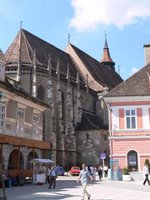 Church dominates the city’s center. The church was built between 1383 and 1477 with its name coming from a fire in the late 1600s. It remains in use by German Lutherans today. No photographs were permitted inside. The church boasts an impressive collection of more than 100 Turkish rugs collected over the years. With its 4000 pipes, the organ (1839) was built by Buchholz of Berlin. Another interesting detail were the wooden slats covering the water drain in the floor – visitors drop coins through as an offering.
Church dominates the city’s center. The church was built between 1383 and 1477 with its name coming from a fire in the late 1600s. It remains in use by German Lutherans today. No photographs were permitted inside. The church boasts an impressive collection of more than 100 Turkish rugs collected over the years. With its 4000 pipes, the organ (1839) was built by Buchholz of Berlin. Another interesting detail were the wooden slats covering the water drain in the floor – visitors drop coins through as an offering.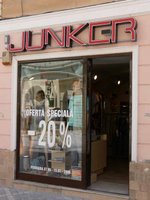
It is not difficult to imagine the past of this major medieval trading center with its Saxon ornate edifices. Modern day celebrates fashion and fusion with backpackers, tourists and residents. – BGR & HSR

No comments:
Post a Comment